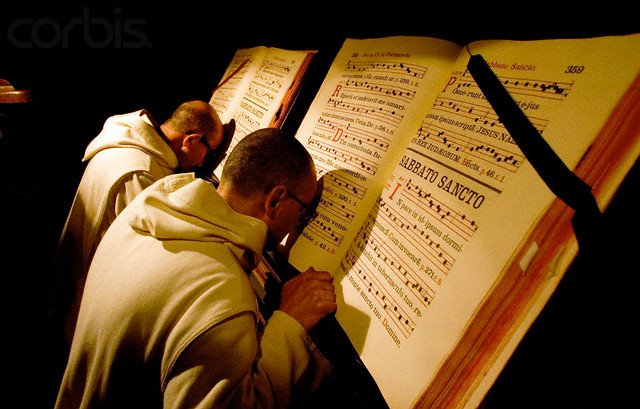 On one level, nothing in the following story is surprising.
Stop and think about it: What kind of class could a mainstream university professor possibly teach these days about monasticism that featured a strong element of student-participation? The key is that it would be impossible to choose one tradition in which to root that experience, because to choose one is to reject others. Thus, the only solution is blending pluriform traditions, creating a kind of do-it-yourself synthetic tradition.
On one level, nothing in the following story is surprising.
Stop and think about it: What kind of class could a mainstream university professor possibly teach these days about monasticism that featured a strong element of student-participation? The key is that it would be impossible to choose one tradition in which to root that experience, because to choose one is to reject others. Thus, the only solution is blending pluriform traditions, creating a kind of do-it-yourself synthetic tradition.
Call it "emerging" academia.
Monks, you see, have to have tradition. Tradition is the frame that surrounds the life of a monk. The goal is to live a tradition and to be transformed by it.
On one level, Kathy Matheson's report for the Associated Press does a good job of revealing some of the obvious elements of a University of Pennsylvania course on "monastic life and asceticism" taught by Justin McDaniel. The goal, readers are told, is a "firsthand experience of what it’s like to be a monk." No, really.
At various periods during the semester, students must forego technology, coffee, physical human contact and certain foods. They’ll also have to wake up at 5 a.m. -- without an alarm clock. That’s just a sample of the restrictions McDaniel imposes in an effort to help students become more observant, aware and disciplined. Each of the constraints represents an actual taboo observed by a monastic religious order. ...
The discipline starts with a dress code for class: White shirts for the men, black shirts for women, and they must sit on opposite sides of the class. No makeup, jewelry or hair products. Laptop computers are prohibited; notes can be taken only with paper and pen. And don’t even think of checking your cell phone for e-mail.
Taboos? Say what?
I assume that there would be other ways of stating that requirement that the students eliminate "physical human contact." That might have something to do with chastity and celibacy. One wonders why the story didn't simply state that clearly, right up front. Perhaps it's more shocking these days to discuss students giving up coffee and cell telephones.
The key to reading this AP report, however, is to strive not to focus on the content of McDaniel's class and to try to figure out the degree to which the reporter did or didn't miss some basic subjects.
But first, what is the tradition that shapes this form of monasticism that is acceptable on an elite university campus?
The course, which focuses primarily on Catholic and Buddhist monastic traditions, stems in part from McDaniel’s own history. An expert on Asian religions, he spent a portion of his post-undergraduate life nearly 20 years ago as a Buddhist monk in Thailand and Laos; he says he’s both a practicing Buddhist and a practicing Catholic.
Restrictions outside class are introduced gradually: Students sacrifice caffeine and alcohol during one week, then swear off vegetables that grow underground in another. The latter rule stems from an extremely nonviolent sect that eschews such produce because uprooting the food could kill insects, McDaniel said.
The real test is a full month of restrictions that begins in mid-March. Students can eat only food in its natural form; nothing processed. They can’t eat when it’s dark, nor speak to anyone while they eat. They must be celibate, foregoing even hugs, handshakes and extended eye contact. No technology except for electric light. They can read for other classes, but news from the outside world is forbidden.
Of course the spiritual father, in this scenario, is "a practicing Buddhist and a practicing Catholic." What other option would be academically acceptable?
However, it is at this point that it's easy to see that this story has a gigantic hole: It contains no information whatsoever about the prayer and worship life of these monks. There is no hint that this class teaches any spiritual disciples, that it attempts to introduce students to any particular worship tradition or to a fusion of several traditions.
Monks without prayer? Monks without worship? This is something like birds without air, fish without water, journalists without questions that yield crucial information.
So what is the bottom line? What is the point of monasticism, if not transcendence, submission and union with Another? What is the purpose of this class?
“It’s not about individual restrictions,” said McDaniel. “It’s about building hyperawareness of yourself and others.”
I do not doubt that the story is accurate in conveying that this is the professor's answer to these crucial questions. However, I find it hard to accept his answer without some kind of information about the spiritual tradition -- wither ancient or postmodern -- used in this academic exercise. Is there, in fact, a monastic tradition in which increasing one's knowledge of self and becoming more aware of others are not initial steps to a higher ultimate goal? It would be good to hear the Catholic/Buddhist professor discuss that issue.
This may be one of the strangest religion ghosts I have ever seen in a news story. Ever.
